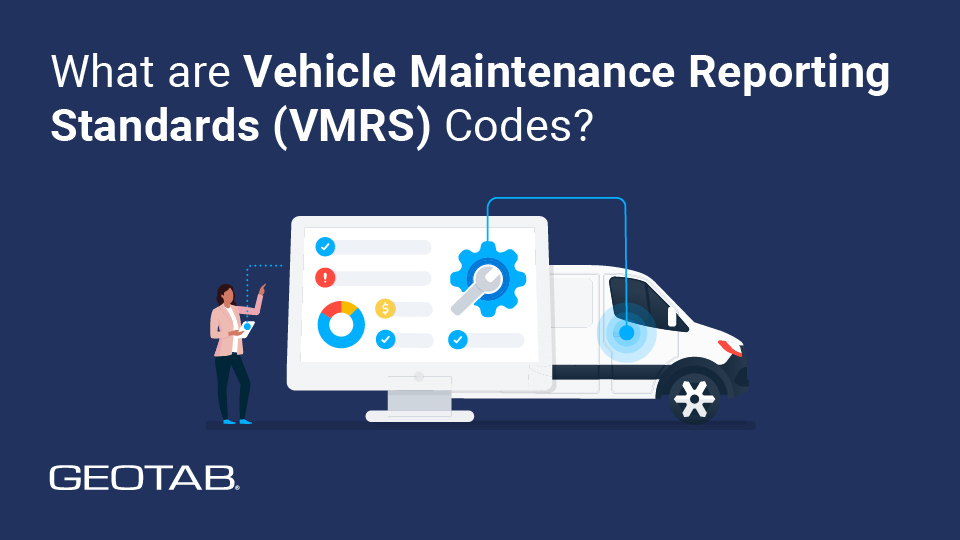What are Vehicle Maintenance Reporting Standards (VMRS) codes?
November 28, 2024
•2 minute read

Definition
- Vehicle Maintenance Reporting Standards (VMRS) codes are a standardized system developed by the American Trucking Associations’ Technology and Maintenance Council (TMC) in 1970 to organize and categorize maintenance information for vehicles and equipment.
What are VMRS codes?
Vehicle Maintenance Reporting Standards (VMRS) codes are a standardized system developed by the American Trucking Associations’ Technology and Maintenance Council (TMC) in 1970 to organize and categorize maintenance information for vehicles and equipment. VMRS codes equip drivers and fleet managers with a universal coding language for maintenance and repair reporting, which improves data accuracy, simplifies equipment maintenance costs and enables better decision-making. In this post, you will learn why VMRS codes are useful in fleet management, how VMRS codes are structured, the benefits of VMRS in maintenance reporting and more.
How to read a VMRS code
VMRS codes are made up of nine digits, grouped in threes (###-###-###). These codes follow a hierarchical structure to provide fleets, repair shops, and manufacturers with detailed reporting and tracking of maintenance issues. Each VMRS code is typically organized into three levels:
- System level: This first three-digit segment identifies the vehicle's main system, such as the engine, transmission or braking system.
- Assembly level: The second three-digit segment describes specific assemblies within the main system, such as the air compressor in the braking system.
- Component level: The last three-digit segment specifies the exact part or component, enabling precise tracking of maintenance activities.
This structured coding helps fleets efficiently manage parts and labor by providing a universal way to analyze and categorize repairs, costs and labor allocation across fleet vehicles.
Common VMRS codes
Fleet managers can look up any VMRS code in comprehensive spreadsheets licensed by the TMC. In addition, most maintenance software can translate VMRS codes for users. To make it easier to find the right code, nine-digit VMRS codes are organized in categories called code keys. Some of the most frequently used code keys include:
- Code key 18: Technician failure: indicates why the technician believes the component has failed.
- Code key 14: Reason for repair: indicates why the asset was taken in for repair.
- Code key 15: Work accomplished: describes what the technician did to the asset.
- Code key 2: Asset types, such as truck, trailer or refrigeration unit.
- Code key 5: Power source: identifies how the asset is powered (e.g., diesel, LNG or CNG)
These codes help standardize how fleets record and share maintenance information, especially for high-frequency repairs. This helps maintenance staff and management quickly identify recurring issues and make data-driven improvements.
How does VMRS impact fleet management?
VMRS codes play a significant role in several key areas of fleet management, including:
- Maintenance management: By providing a clear framework, VMRS codes make it easier for fleet managers to monitor vehicle performance and determine maintenance needs. This helps fleets plan repairs and organize labor efficiently and with the least possible disruption to operations.
- Control costs: VMRS coding allows fleets to accurately track repair costs, identify expensive patterns and make adjustments to optimize fleet performance. This helps fleet managers better allocate budgets and control expenses associated with parts, labor and downtime.
- Ensuring compliance: The universal language of VMRS codes makes it easier for fleet managers to prepare for compliance reports and regulatory inspections.
- Preventive maintenance: VMRS codes enable fleet managers to track wear and tear on critical components to anticipate maintenance needs. This optimizes fleet operations by minimizing unplanned downtime and extending vehicle life.
Benefits of VMRS in maintenance reporting
VMRS codes add several benefits to fleet maintenance reporting, including:
- Enhancing performance records through accurate coding: With VMRS, maintenance histories are precise and easily accessible. This helps managers spot trends in repairs, vehicle performance and each driver’s impact on maintenance needs.
- Cost analysis and financial implications of maintenance: VMRS codes help fleet managers assess the financial impact of specific repairs by providing detailed cost analysis. This makes budgeting more accurate and facilitates cost-saving strategies.
- Reduced data entry errors through automating the process: Many fleet management systems integrate VMRS codes using automation to reduce the risk of manual data entry errors. This automation also speeds up the reporting process and keeps data consistent across systems.
Frequently Asked Questions
One common challenge is ensuring that all staff are trained in using VMRS codes accurately. Misinterpretation or inconsistent use of codes can lead to incomplete or inaccurate data, leading to inefficient maintenance spending and downtime.
The best ways to maintain VMRS accuracy are regular training for maintenance staff, consistent code reviews and periodic audits of maintenance records. Fleets that use software that integrates VMRS also tend to see fewer manual entry errors.
More than 34,000 VMRS codes currently cover various vehicle systems, assemblies and components. The TMC also expands the list yearly to address new technology and components.
VMRS codes are updated annually to reflect industry changes, including new technologies, parts and regulatory requirements. Fleet managers should stay up-to-date by subscribing to TMC updates and training their staff accordingly.
Table of Contents
Other Stories

What is telemetry? How it works and why fleets need it
December 24, 2025
4 minute read

What is a CAN Bus? How it impacts fleet management
December 1, 2025
6 minute read

August 5, 2025
5 minute read